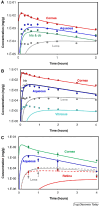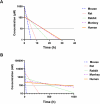Mathematical Models of Ocular Drug Delivery
- PMID: 39287588
- PMCID: PMC11412384
- DOI: 10.1167/iovs.65.11.28
Mathematical Models of Ocular Drug Delivery
Abstract
Drug delivery is an important factor for the success of ocular drug treatment. However, several physical, biochemical, and flow-related barriers limit drug exposure of anterior and posterior ocular target tissues during drug treatment via topical, subconjunctival, intravitreal, or systemic routes. Mathematical models encompass various barriers so that their joint influence on pharmacokinetics (PKs) can be simulated in an integrated fashion. The models are useful in predicting PKs and even pharmacodynamics (PDs) of administered drugs thereby fostering development of new drug molecules and drug delivery systems. Furthermore, the models are potentially useful in interspecies translation and probing of disease effects on PKs. In this review article, we introduce current modeling methods (noncompartmental analyses, compartmental and physiologically based PK models, and finite element models) in ocular PKs and related drug delivery. The roles of top-down models and bottom-up simulations are discussed. Furthermore, we present some future challenges, such as modeling of intra-tissue distribution, prediction of drug responses, quantitative systems pharmacology, and possibilities of artificial intelligence.
Conflict of interest statement
Disclosure:
Figures





















Similar articles
-
Recent advances in ophthalmic preparations: Ocular barriers, dosage forms and routes of administration.Int J Pharm. 2021 Oct 25;608:121105. doi: 10.1016/j.ijpharm.2021.121105. Epub 2021 Sep 17. Int J Pharm. 2021. PMID: 34537269 Review.
-
Ocular Pharmacology.J Clin Pharmacol. 2024 Sep;64(9):1068-1082. doi: 10.1002/jcph.2451. Epub 2024 May 6. J Clin Pharmacol. 2024. PMID: 38708561 Review.
-
Ocular Drug Delivery - New Strategies for Targeting Anterior and Posterior Segments of the Eye.Curr Pharm Des. 2016;22(9):1135-46. doi: 10.2174/1381612822666151216145900. Curr Pharm Des. 2016. PMID: 26675225 Review.
-
Micelles: Promising Ocular Drug Carriers for Anterior and Posterior Segment Diseases.J Ocul Pharmacol Ther. 2020 Jul/Aug;36(6):323-341. doi: 10.1089/jop.2019.0109. Epub 2020 Apr 20. J Ocul Pharmacol Ther. 2020. PMID: 32310723 Review.
-
A review of implantable intravitreal drug delivery technologies for the treatment of posterior segment eye diseases.J Pharm Sci. 2010 May;99(5):2219-39. doi: 10.1002/jps.21987. J Pharm Sci. 2010. PMID: 19894268 Review.
Cited by
-
A quantum-inspired neural fuzzy sliding mode control framework for fractional-order modeling of intraocular pressure regulation and optic nerve damage in glaucoma.Sci Rep. 2025 Jul 2;15(1):23438. doi: 10.1038/s41598-025-99501-y. Sci Rep. 2025. PMID: 40604309 Free PMC article.
-
Mathematical Models of Topically and Intravitreally Applied Ranibizumab.Invest Ophthalmol Vis Sci. 2025 Aug 1;66(11):45. doi: 10.1167/iovs.66.11.45. Invest Ophthalmol Vis Sci. 2025. PMID: 40833326 Free PMC article.
-
Nanovesicular Drug Delivery Systems for Rare Ocular Diseases: Advances, Challenges, and Future Directions.AAPS PharmSciTech. 2025 Jul 23;26(7):197. doi: 10.1208/s12249-025-03159-8. AAPS PharmSciTech. 2025. PMID: 40702295 Review.
-
Advances and therapeutic opportunities in visual cycle modulation.Prog Retin Eye Res. 2025 May;106:101360. doi: 10.1016/j.preteyeres.2025.101360. Epub 2025 Apr 23. Prog Retin Eye Res. 2025. PMID: 40280538 Free PMC article. Review.
-
OBM1701 Alleviates Choroidal Neovascularization in Experimental Animals Via Suppressing the Expression of HIF-1α in Retinal Pigment Epithelial Cells.Transl Vis Sci Technol. 2025 Aug 1;14(8):21. doi: 10.1167/tvst.14.8.21. Transl Vis Sci Technol. 2025. PMID: 40828526 Free PMC article.
References
-
- Urtti A. Challenges and obstacles of ocular pharmacokinetics and drug delivery. Adv Drug Deliv Rev. 2006; 58(11): 1131–1135. - PubMed
-
- Fayyaz A, Ranta VP, Toropainen E, et al. .. Topical ocular pharmacokinetics and bioavailability for a cocktail of atenolol, timolol and betaxolol in rabbits. Eur J Pharm Sci. 2020; 155: 105553. - PubMed
-
- del Amo EM, Urtti A.. Current and future ophthalmic drug delivery systems. A shift to the posterior segment. Drug Discov Today. 2008; 13(3): 135–143. - PubMed
-
- Del Amo EM, Vellonen KS, Kidron H, Urtti A.. Intravitreal clearance and volume of distribution of compounds in rabbits: in silico prediction and pharmacokinetic simulations for drug development. Eur Journal of Pharm Biopharm. 2015; 95: 215–226. - PubMed
-
- Zhu Q, Ziemssen F, Henke-Fahle S, et al. .. Vitreous levels of bevacizumab and vascular endothelial growth factor-A in patients with choroidal neovascularization. Ophthalmology. 2008; 115(10): 1750–1755.e1. - PubMed
Publication types
MeSH terms
Substances
LinkOut - more resources
Full Text Sources
Miscellaneous

